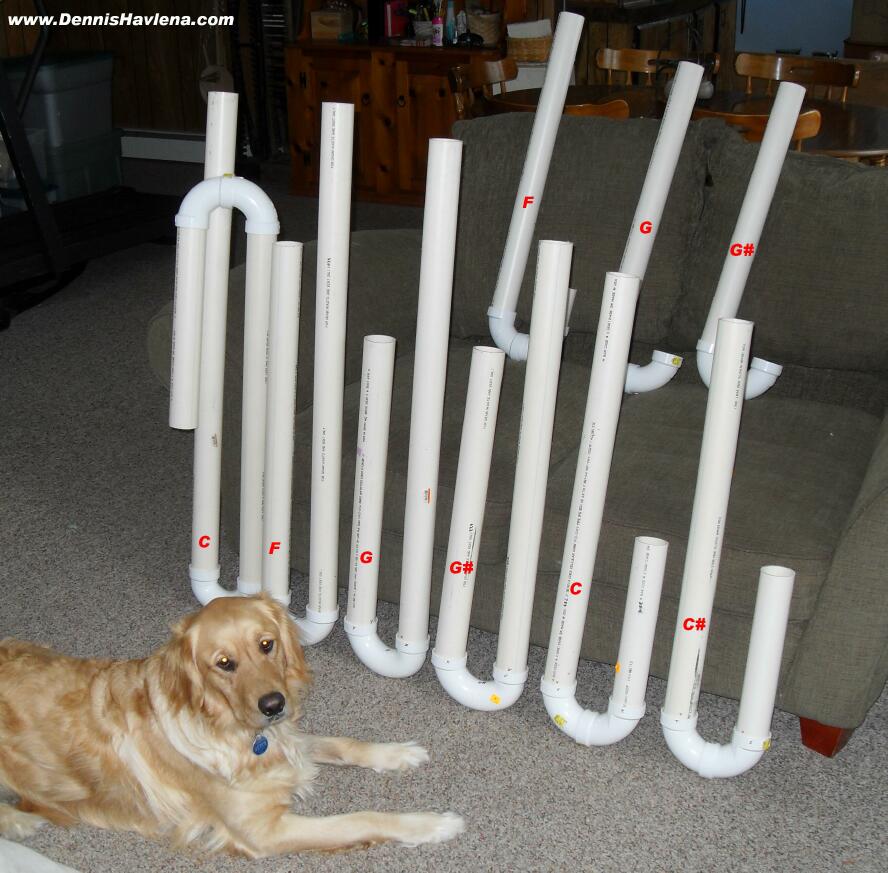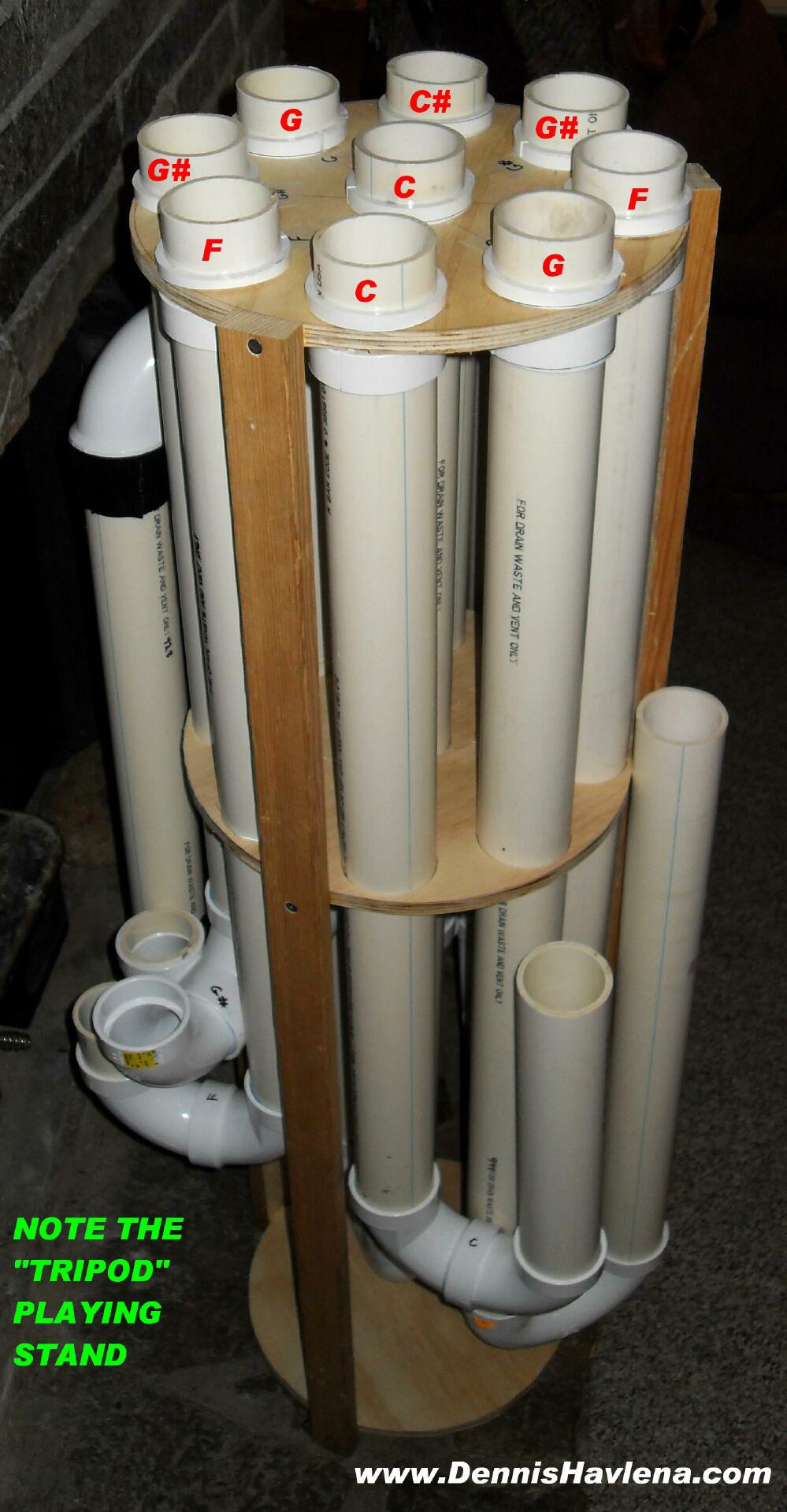
Pre PS: This article is not yet completed to my satisfaction.
>>>>>>>>>>>>>>>>>>>>>>>>>>>>>>>>>>>>>>>>>>>>>>>>>>>>>>>>>>>>>>>>>>>>>
PLEASE NOTE: A Swiss-made hang drum is VERY difficult to obtain
these days. Pantheon Steel, a maker of beautiful steel drums ("steel
pans") has come to the rescue in the form of their "HALO" which
has reached the production stage and orders are being taken! Please contact
them at pantheonsteel.com They have produced an introductory video which
at present is on youtube. Input the two keywords: halo pantheonsteel.
In an attempt to familiarize myself with the "Ake Bono" scale that the first
HALOs will be tuned to, I've built a version of my PVC "hang drum reminiscent"
instrument that I came up with a couple of years ago but this time, with
9 notes (8 along the circumference & one - the "ding" central -- in this
case tuned a note lower - to C, two octaves below piano's middle C.
The resulting notes are in the same key, scale and relative note position
as the HALO. In other words, it's set-up and pitched just like the HALO.
Due to the long pipe length/low overall pitch and large diameter PVC pipe
used, this beast is very loud, resonant and fine sounding. It weighs 22 Lbs,
the same as my upright bass.
>>>>>>>>>>>>>>>>>>>>>>>>>>>>>>>>>>>>>>>>>>>>>>>>>>>>>>>>>>>>>>>>>>>>>
CLICK
HERE for a short YouTube video showing this PVC instrument being played



This instrument is played with dollar-store flip-flop beach sandals.
It is pitched in the Ake Bono scale of (low to high):
low-C (central "Ding"); low-F, G, G#, C (an octave above low-c), C#, hi-F, hi-G, hi-G#
Unlike my first PVC tubing instrument (see elsewhere in my webpage), this one uses
larger diameter 2", schedule 40 PVC, but is not that much larger or heavier.
The whole affair cost on the order of $60 - using all new parts
and was a 2-day, spare-time project. Just visited Home Depot where prices were nearly
half of what I paid locally at the neighborhood hardware store!
Construction details:
The thing is made entirely from what's called 2 inch schedule 40 PVC plumbing pipe
available at any hardware store.
The stuff is white and the 2" measurement is the inside diameter. Four ten-foot
lengths turned out to be just enough for all of the nine notes. A ten foot length
of this pipe cost me about $6.00 locally. The only other PVC parts needed are ten
female-to-male 90 degree elbows and ten female-to-female 90 degree elbows
(these make the ten 180 degree "U-turns").
Safety note - some people tell me they've worked with PVC pipe all their lives
with no health issues at all, others tell me that the stuff is dangerous. Not
one to believe experts, I err on the side of safety. I cut all of the tubes for this
one with a regular carpenter's hand saw - set up outside - upwind (with a stiff breeze)
blowing away the noxious PVC dust).
Construction of the PVC part of this instrument is very straightforward. No real
instructions are needed other than careful observation of the photos. The central
"ding" lowest note (pitched to the C, is the only note where the tubing has to be
folded back on itself twice (all of the other notes are folded back on themselves
just one time). The reason for this double folding is that the tube would be more
than 7 feet long or so if left straight. As mentioned, all of the other notes are
folded back on themselves only once -- I folded them not necessarily because they'd
be too long, but (although more expensive & making for a bit heavier instrument)
when folded, the business end of each tube is pointing upwards - projecting the
sound directly at the player, instead of downwards towards the ground.
Cut the pipe to these measurements:
Lowest note - C (two octaves below piano's middle C) - corresponds to the "ding"
(the central on a metal hang drum. There are three seperate lengths of PVC pipe needed
"Ding") for this note. Cut the longest to 1040 MM. The 2nd longest to 793 MM and
the shortest to at least 508 MM* . Carefully cut off small pieces of this last pipe
until it is tuned exactly to C.
2nd lowest -- F (in the 2nd octave below piano's middle C). This (and all the remaining
pipes) has two seperate lengths of PVC pipe. Cut the longest to 1039 MM and
the shortest to at least 843 MM*. Carefully cut off small pieces of the shorter pipe
until it is tuned exactly to F).
3rd lowest -- G (in the 2nd octave below piano's middle C). Cut the longest pipe to 994 MM
and the shortest to at least 689 MM*. Carefully cut off small pieces of the shorter pipe
until it is tuned exactly to G).
4th lowest -- G# (in the 2nd octave below piano's middle C). Cut the longest pipe to 838 MM
and the shortest to at least 703 MM*. Carefully cut off small pieces of the shorter pipe
until it is tuned exactly to G#).
5th lowest -- C (one octave below piano's middle C). Cut the longest pipe to 788 MM
and the shortest to at least 404 MM*. Carefully cut off small pieces of the shorter pipe
until it is tuned exactly to C).
6th lowest -- C# (in the octave below piano's middle C). Cut the longest pipe to 740 MM
and the shortest to at least 400 MM*. Carefully cut off small pieces of the shorter pipe
until it is tuned exactly to C#).
7th lowest -- F (in the octave below piano's middle C). Cut the longest pipe to 703 MM
and the shortest to at least 200 MM*. Carefully cut off small pieces of the shorter pipe
until it is tuned exactly to F).
8th lowest -- G (in the octave below piano's middle C) Cut the longest pipe to 603 MM
and the shortest to at least 120 MM*. Carefully cut off small pieces of the shorter pipe
until it is tuned exactly to C#).
9TH lowest -- G# (in the octave below piano's middle C) Cut the longest pipe to 600 MM
and the shortest to at least 123 MM*. Carefully cut off small pieces of this 2nd pipe
until it is tuned exactly to G#).
* The figure shown for these "terminal" pipes is longer than is needed for the desired pitch --
the idea here being to experimentally cut off small lengths of pipe until it is tuned exactly to C#).
The reason I don't give exact dimensions for these last pipes is that 90 degree elbows can vary a lot
in size/length and basic type, manufacturer-to-manufacturer -- not to mention variation of the PVC
pipe itself.
Hold off gluing anything until the tubes are all mounted and positioned (& tuned) in the wooden
mounting disks -- a bit of jockying is needed to get all these PVC intestines to fit compactly.
Wooden mounting disks:
The tubes slide through two wooden 3/8" thick plywood disks that are spaced about
15 inches apart, into which have been drilled 9 holes (one central and eight around the
circumferance). Hot-gluing the tubes in makes a solid and rigid affair. Large diameter hole saws
are widely available -- alternately, a simple keyhole saw will do the job.
I left the tops of each tube project about an inch above the surface of the top disk so
as to keep from hitting the wood disk with the flip-flop whappers while playing.
A playing Stand for this octopus of pipes will be described shortly - as will further
construction details.
Dennis Havlena - W8MI
Mackinac Straits, northern Michigan
dhavlena@gmail.com
3/29/09
Click here to access my webpage